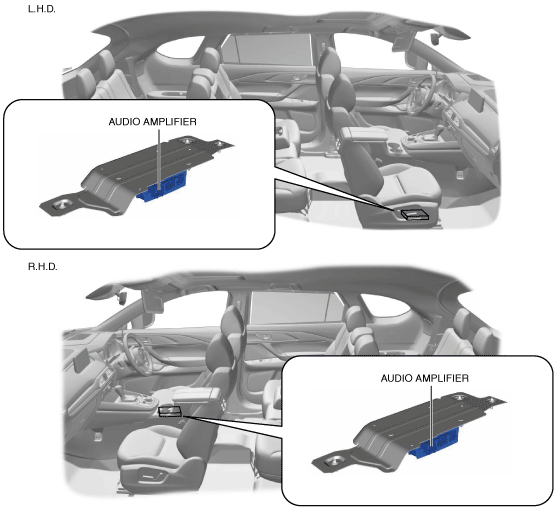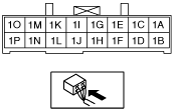 |
AUDIO AMPLIFIER
id092000011200
Purpose
Function
Road noise correction system (AudioPilot®)
On-board diagnostic function
Active engine sound function
Structure/Construction
ac9wzn00001215
|
Terminal Layout and Signal
L.H.D.
|
Terminal |
Signal |
|
|---|---|---|
 |
1A
|
Bass-box output (+)
|
|
1B
|
Bass-box output (-)
|
|
|
1C
|
—
|
|
|
1D
|
—
|
|
|
1E
|
—
|
|
|
1F
|
—
|
|
|
1G
|
AudioPilot® (+)
|
|
|
1H
|
AudioPilot® (-)
|
|
|
1I
|
Rear speaker RH side input(+)
|
|
|
1J
|
Rear speaker RH side input (-)
|
|
|
1K
|
Rear speaker LH side input (+)
|
|
|
1L
|
Rear speaker LH side input (-)
|
|
|
1M
|
Front speaker RH side input (+)
|
|
|
1N
|
Front speaker RH side input (-)
|
|
|
1O
|
Front speaker LH side input (+)
|
|
|
1P
|
Front speaker LH side input (-)
|
|
 |
2A
|
Rear door speaker output RH (+)
|
|
2B
|
Rear door speaker output RH (-)
|
|
|
2C
|
Front side speaker output LH (-)
|
|
|
2D
|
Audio amplifier control
|
|
|
2E
|
Front side speaker output LH (+)
|
|
|
2F
|
Audio amplifier signal
|
|
|
2G
|
Front center speaker output (+)
|
|
|
2H
|
Pulse width modulation (PWM) control
|
|
|
2I
|
Front center speaker output (-)
|
|
|
2J
|
—
|
|
|
2K
|
Front side speaker output RH (-)
|
|
|
2L
|
CAN_H
|
|
|
2M
|
Front side speaker output RH (+)
|
|
|
2N
|
CAN_L
|
|
|
2O
|
Rear speaker LH/RH (+)
|
|
|
2P
|
Rear speaker LH/RH (-)
|
|
 |
3A
|
B+
|
|
3B
|
Ground
|
|
|
3C
|
Front door speaker output LH (+) / tweeter output LH (+)
|
|
|
3D
|
Front door speaker output LH (-) / tweeter output LH (-)
|
|
|
3E
|
Front door speaker output RH (+) / tweeter output RH (+)
|
|
|
3F
|
Front door speaker output RH (-) / tweeter output RH (-)
|
|
|
3G
|
Rear door speaker output LH (-)
|
|
|
3H
|
Rear door speaker output LH (+)
|
|
R.H.D.
|
Terminal |
Signal |
|
|---|---|---|
 |
1A
|
Bass-box output (+)
|
|
1B
|
Bass-box output (-)
|
|
|
1C
|
—
|
|
|
1D
|
—
|
|
|
1E
|
—
|
|
|
1F
|
—
|
|
|
1G
|
AudioPilot® (+)
|
|
|
1H
|
AudioPilot® (-)
|
|
|
1I
|
Rear speaker LH side input(+)
|
|
|
1J
|
Rear speaker LH side input (-)
|
|
|
1K
|
Rear speaker RH side input (+)
|
|
|
1L
|
Rear speaker RH side input (-)
|
|
|
1M
|
Front speaker LH side input (+)
|
|
|
1N
|
Front speaker LH side input (-)
|
|
|
1O
|
Front speaker RH side input (+)
|
|
|
1P
|
Front speaker RH side input (-)
|
|
 |
2A
|
Rear door speaker output LH (+)
|
|
2B
|
Rear door speaker output LH (-)
|
|
|
2C
|
Front side speaker output RH (-)
|
|
|
2D
|
Audio amplifier control
|
|
|
2E
|
Front side speaker output RH (+)
|
|
|
2F
|
Audio amplifier signal
|
|
|
2G
|
Front center speaker output (+)
|
|
|
2H
|
Pulse width modulation (PWM) control
|
|
|
2I
|
Front center speaker output (-)
|
|
|
2J
|
—
|
|
|
2K
|
Front side speaker output LH (-)
|
|
|
2L
|
CAN_H
|
|
|
2M
|
Front side speaker output LH (+)
|
|
|
2N
|
CAN_L
|
|
|
2O
|
Rear speaker LH/RH (+)
|
|
|
2P
|
Rear speaker LH/RH (-)
|
|
 |
3A
|
B+
|
|
3B
|
Ground
|
|
|
3C
|
Front door speaker output RH (+) / tweeter output RH (+)
|
|
|
3D
|
Front door speaker output RH (-) / tweeter output RH (-)
|
|
|
3E
|
Front door speaker output LH (+) / tweeter output LH (+)
|
|
|
3F
|
Front door speaker output LH (-) / tweeter output LH (-)
|
|
|
3G
|
Rear door speaker output RH (-)
|
|
|
3H
|
Rear door speaker output RH (+)
|
|
Operation
ac9wzn00001216
|
Active engine sound function
1. When the ignition is switched ON (engine off or on), the PCM sends the engine information and the ignition condition, and the instrument cluster sends vehicle specification information to the audio amplifier via a CAN signal.
2. When the engine information and the specification information for the ignition condition and vehicle are received, the audio amplifier selects the equalizer built into the audio amplifier and sets the frequency output from the speaker.
3. The PCM sends the engine condition signal and acceleration pedal angle, the TCM sends the shift range position, and the instrument cluster sends a driver-side door latch switch on signal and rear door latch switch on signal to the audio amplifier via a CAN signal.
4. The audio amplifier analyzes the engine load conditions, calculates the range of insufficient engine sound, and produces a supplemental signal based on the signal received from the PCM, TCM and instrument cluster.
5. The audio amplifier sends the produced supplemental signal to the front door speaker and the front side speaker.
6. The front door speaker and the front side speaker output a sound for supplementing the engine sound based on the produced supplemental signal sent from the audio amplifier.
ac9wzn00001740
|
Fail-safe